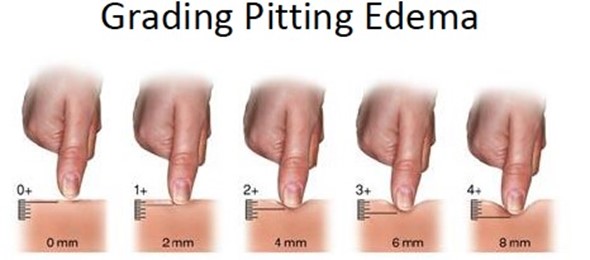The nurse performed an assessment on a patient's upper extremities. All findings were within normal limits. Which reflects the most accurate and complete terminology used when documenting these normal results?
Skin was pink, warm, dry, and intact. Capillary refill was less than 5 seconds in all fingers. Radial pulses were +4 and equal bilaterally. Grips were strong 10 out of 10 and equal bilaterally.
Skin was pink, warm, dry, and intact. Capillary refill was less than 3 seconds in all fingers. Radial pulses were +2 and equal bilaterally. Grips were strong 5/5 and equal bilaterally.
Skin was pink, warm, dry, and intact. Capillary refill was more than 3 seconds in all fingers. Radial pulses were 1 and equal. Grips were strong 4/4 and symmetrical.
Skin was warm and dry and intact. Capillary refill was less than 3 seconds in all fingers. Radial pulses were 3. Grips were strong and equal.
The Correct Answer is B
A. Skin was pink, warm, dry, and intact. Capillary refill was less than 5 seconds in all fingers. Radial pulses were +4 and equal bilaterally. Grips were strong 10 out of 10 and equal bilaterally:
Incorrect. Capillary refill should be less than 2-3 seconds for normal findings; less than 5 seconds would be too long and could indicate poor perfusion. Radial pulses graded +4 are not typical and suggest a bounding pulse, which could indicate an abnormal condition. Grips graded 10/10 is not the standard grading system; typically, grips are graded out of 5.
B. Skin was pink, warm, dry, and intact. Capillary refill was less than 3 seconds in all fingers. Radial pulses were +2 and equal bilaterally. Grips were strong 5/5 and equal bilaterally:
Correct. This option uses proper terminology. Capillary refill of less than 3 seconds is normal, radial pulses graded +2 are normal, and grips are appropriately graded on a 5-point scale, with 5/5 being the normal strength.
C. Skin was pink, warm, dry, and intact. Capillary refill was more than 3 seconds in all fingers. Radial pulses were 1 and equal. Grips were strong 4/4 and symmetrical:
Incorrect. Capillary refill of more than 3 seconds indicates delayed perfusion, which is abnormal. Radial pulses graded 1 indicate a weak pulse, which is not within normal limits. Additionally, grips are usually graded out of 5, not 4.
D. Skin was warm and dry and intact. Capillary refill was less than 3 seconds in all fingers. Radial pulses were 3. Grips were strong and equal:
Incorrect. While some aspects are correct (capillary refill), the pulse grading system is incomplete here. Radial pulses should be recorded as +1 to +4, and +3 would indicate a stronger-than-normal pulse, which is not typical for normal findings. Grip strength is not fully documented here either, as it should include a scale (e.g., 5/5).
Nursing Test Bank
Naxlex Comprehensive Predictor Exams
Related Questions
Correct Answer is D
Explanation
A. 2+ Pitting Edema:This refers to moderate pitting edema where the indentation is approximately 4 mm and disappears within 10-15 seconds.
B. 3+ Pitting Edema:This refers to moderately severe pitting edema where the indentation is approximately 6 mm and may last longer than 1 minute but does not remain for as long as 4 minutes.
C. 1+ Non-Pitting Edema:This grade refers to mild pitting edema with a 2 mm indentation that quickly disappears within a few seconds.
D. 4+ Pitting Edema:4+ pitting edema is characterized by a very deep pit (approximately 8 mm) that may last 2-5 minutes or more. This matches the scenario where the pit is 8 mm deep and remains for 4 minutes.

Correct Answer is C
Explanation
The correct answer is choice C: Listen with the stethoscope at the fifth intercostal space left mid clavicular line. This is the correct location to auscultate the apical pulse or apical heart rate. The apical pulse is the sound of the heart beating heard through a stethoscope placed over the apex of the heart, which is located at the fifth intercostal space at the left mid-clavicular line. The second intercostal space at the left sternum is the location to auscultate the aortic valve, while the fifth intercostal space at the sternum is the location to auscultate the tricuspid valve. The neck to the right of the coracoid process is not a location to auscultate the apical pulse.
Whether you are a student looking to ace your exams or a practicing nurse seeking to enhance your expertise , our nursing education contents will empower you with the confidence and competence to make a difference in the lives of patients and become a respected leader in the healthcare field.
Visit Naxlex, invest in your future and unlock endless possibilities with our unparalleled nursing education contents today
Report Wrong Answer on the Current Question
Do you disagree with the answer? If yes, what is your expected answer? Explain.
Kindly be descriptive with the issue you are facing.
